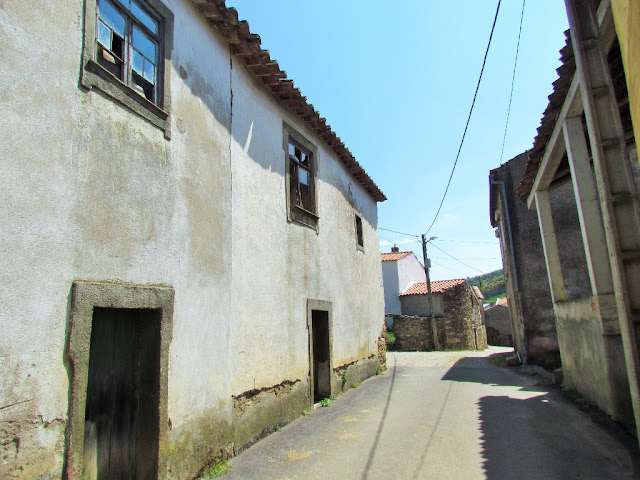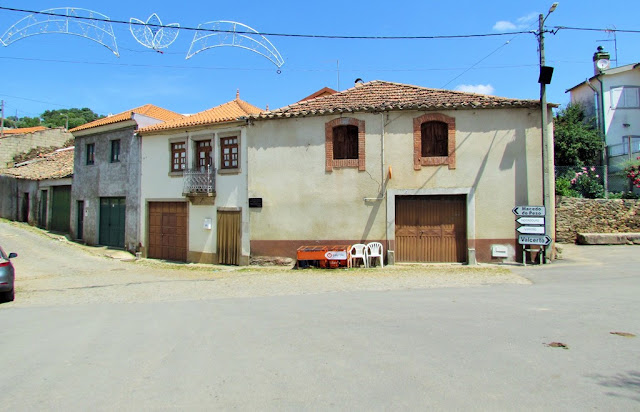SÃO MARTINHO DO PESO
41.42335º N; 6.61519º W
São Martinho do Peso is a Portuguese parish in the municipality of Mogadouro, with an area of 52.01 km² and 355 inhabitants (2021). Its population density is 4.9 inhabitants/km².
The village of S. Martinho do Peso, parish seat, is 14 km away from Mogadouro, located at the extreme north of Mogadouro, eastwards in relation to the county seat, and has attached the towns of Valcerto, Macedo do Peso and Peso . It faces the parishes of Azinhoso (West), Castanheira and Penas Roias (South) and Saldanha (East).
The main monuments of S. Martinho are all of a religious nature, namely the chapel of Santa Cruz (ordered to be erected by the Távoras), the chapel of S. Martinho and the chapel of S. Pantaleão.
The parish of S. Martinho is, for most of its perimeter, surrounded by rivers, in addition to the stream that crosses it, dividing it in half, and yet another stream at the end of Peso, the stream of Peso.
The culture of lentils has always been remarkable in these lands. However, subjugated to the economic power of the large producers, it fell into disuse and remains, today, in small plots of private monoculture. We'll see if the economic crisis doesn't make old habits grow, less consumerist and more attached to cultivating the land for self-consumption and autonomous production.
In terms of handicrafts, the traditions maintained, some at a cost, in wicker basketry, carpet weaving, wool and linen quilts, lace and embroidery typical of the region and wooden miniatures stand out.
Festivities and pilgrimages: Senhor dos Aflitos (May), S. Martinho (November 11), S. Bartolomeu (August 24), S. Matias (February 23), S. Sebastião (1st Sunday in August), Santa Bárbara (1st Sunday of September) and Festa do Ramo (Fat Sunday).
Gastronomy: Mirandese steak and all the traditional dishes of the region.
Tourism
The Mother Church, dating from the 15th century and later restored in the 17th century, is the main monument of the parish. Within the parish's religious heritage, the chapels of Senhor dos Aflitos, S. Martinho and S. Pantaleão and the Mother Church of Vale Certo are also noteworthy.
A portion of a marble colonnade, found in a vegetable garden in Prado, was one of the most recent archaeological finds to excite researchers, who believe that there was a temple in the area and, probably, a village around that same temple. Reinforcing this hypothesis, a coin from the 2nd century and a funerary tombstone of rare paleographic value were also discovered. With inscriptions from Proteus, from the 7th century, this tombstone is currently in the museum of Bragança. In Ribeira de Peso there is a beautiful stretch of landscape topped by a Roman bridge called Gamona, architecturally admirable due to the layout without handles.
“O Carril”, fifty years ago, was the most characteristic, populous and poor neighborhood in the village, where pigs were not killed. It was the neighborhood of the “geireira people”, the mowing and other day services, without any whitewashed houses. There were no glass windows, only wooden ones, small and few. On Carril, all the inhabitants had nicknames and they were the ones who made the most of these jokes. Today, it's an abandoned neighborhood with two or three residents. The positive side is that, due to emigration and the reforms it generated, there are no poor people in the village anymore.
The water from the spring of S. Martinho has recognized diuretic qualities and is highly appreciated by all who visit it. Another natural treasure is the natural beach of Muro, on the Angueira River. In this water course there are medieval bridges and water mills.
The cliffs of Pena da Cruz, over 20 meters high, where crows still make their nest today, are part of the childhood and youth memories of many boys, who grew up there and climbed them, at the risk of their own lives, to steal their eggs.
In 1950, there were around 15 windmills in S. Martinho, all in operation during the winter and spring months, but it was on the Angueira stream that the special one called Pisão stood out, as it was used to macerate wool blankets. woven on manual looms, lifting their fur and turning them into fluffy blankets. In the 1970s, mills for wheat and rye were founded in Variz, and soon after in S. Martinho, which worked for a dozen years. Today, there is only one in Tó, which serves the most nostalgic of the whole region, with the product of other times: rye milling for rye and garlic soups. Now, housewives light the wood ovens only around Easter, to make the cakes that preserve the smell and flavor of wood that only these ovens imprint on them: industrial cooking is not enough.
Dovecotes are cylindrical constructions, with walls rising about a meter and a half above the flat tile roof, with the door about a meter high and eighty centimeters off the ground, to prevent snakes from entering. The dovecotes, about 12 in other times, had colonies that numbered in the hundreds, as the wild birds fed freely in the fields. Now, there is only one in activity and with pigeons fed by the owners with the leftovers from the meager crops. In other times, the boys poured salted wheat into the springs and drinking fountains so that the youngsters, eating and drinking too much, would become numb, becoming easy prey in poaching.



































































































































.JPG)






